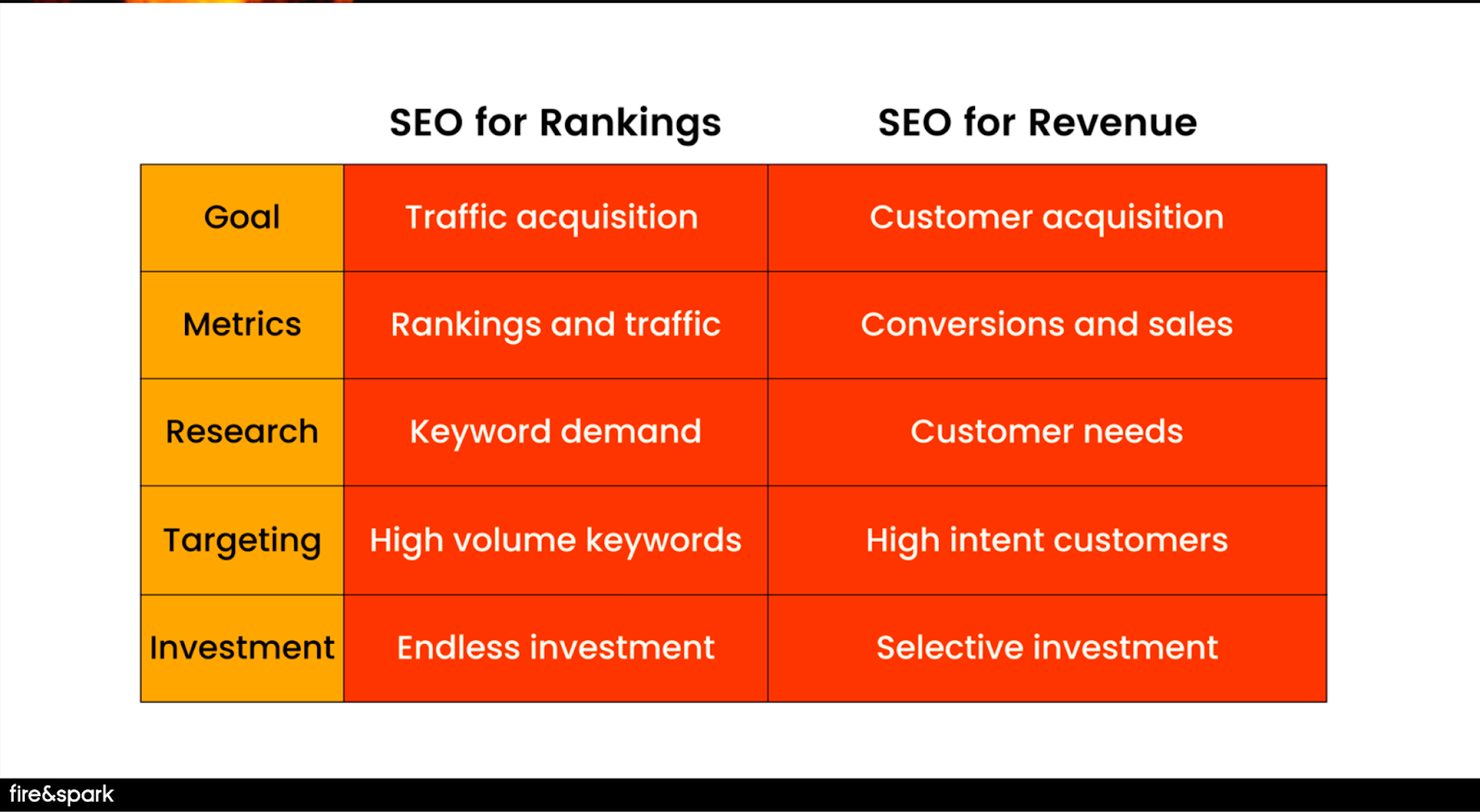Table of Contents
Your success as a content marketer or demand generation marketer depends on SEO. However, much of the common advice on the subject is either outdated or simply never really worked.
At this year’s Content Marketing World conference, Dale Bertrand, founder of fire&spark, set the record straight with practical advice in his session, “Evidence-based SEO Strategies: Busting ‘SEO Best Practices’ and Other Marketing Myths.” We left his presentation with a notepad full of ideas to put into action.
Start By Shifting Your Mindset
Much of the conventional wisdom and best practices surrounding SEO revolve around helping you rank highly, with the goal of generating traffic. Because of these goals, approaches often focus on creating content for the most in-demand keywords to boost traffic.
However, high traffic doesn’t mean conversions and increased revenue.
Yet, this obsession with increasing traffic as the core goal of SEO operations led to companies finding themselves endlessly investing solely to either improve or keep their rank.
But Bertrand implores us to think beyond rankings. Because of the high cost and lack of measurable results in terms of increased sales, organizations should shift their SEO focus to growing revenue. By focusing on customer needs, organizations can then target high-intent customers by measuring conversions and sales metrics. This approach also means organizations can now selectively invest in customers looking to buy instead of continually trying to attract anyone to the site, even those who will likely never buy the product.
Here are Bertrand’s top takeaways on what you really need to prioritize to adopt a revenue-focused SEO strategy and make it work for you:
Tip No. 1: Know Your Customers
While traditional SEO focuses on what keywords customers put into search engines, revenue-based SEO requires a shift. Marketers must go deeper than keywords and focus on understanding their customers’ needs. Bertrand offers a few steps to help you really get to know your customers:
-
Start by learning their pain points and what questions they want answered
-
Next, consider their preferences and worldviews
-
Finally, learn where your potential customers hang out — such as a specific website or social media
After rounding up all of this intel, you’ll have what you need to conduct SEO research around the information your customers actually need and produce high-quality content to match.
studioID Tip:
Round up a few key stakeholders from your sales team and product team and interview them to uncover customer pain points. Ask questions like:
-
What are the most common problems our customers come to us to solve?
-
What products/services are they finding the most value in?
-
What products/services do they have the most trouble seeing the value in?
-
What do our customers ask about/ensure before they sign a deal with us?
-
Do you ever run into scenarios where you wish you had content to help explain or support a case you’re trying to make?
You can then marry this information with keyword research to uncover the correct keywords to use that have the highest purchase intent.
💵 Related Resource: Sales, Empowered: A Roadie Masterclass in Full-Funnel Campaigns That Win Deals
Tip No. 2 Create Content That Converts Customers
When measuring rankings, organizations tend to create content that attracts readers but fails to turn them into customers, often because of intent. While articles often rank high, companies often find that more interactive content converts views to customers.
Bertrand offers up a plethora of revenue-focused ‘content recipes’ to experiment with based on your brand and its goals:
-
Niche calculator tool
-
E.g. A home-lending company might create a personalized mortgage calculator
-
-
Niche buying guides
-
E.g. A home furnishing store might create a ‘Blackout Curtains Buying Guide’
-
-
Q&A roundup content
-
E.g. An addiction treatment center might create a ‘FAQs about Suboxone’ page with a 1:1 intent CTA of ‘Is Suboxone right for you? Find out now’
-
-
Niche service pages
-
E.g. A waste management facility might create a dedicated ‘Hospital Waste Disposal’ service page
-
-
Comparison content
-
E.g. A car insurance company might create a comparison page that details the pros, cons, and costs of leading providers and policies
-
studioID Tip:
Find your balancing act. The strongest marketing programs out there today produce brand-to-demand marketing to captivate & nurture their audiences with thought leadership and convert them with impactful bottom-of-funnel content.
Tip No. 3: Select the Right Metrics
The cornerstone of SEO is measurement. However, many marketers head down the wrong SEO path by selecting and prioritizing the wrong metrics. Organizations often focus on rankings and organic traffic because they are easier to measure. Instead, marketers should consider engagement and organic sales when measuring revenue-focused SEO success.
Bertrand provides a helpful chart to help you understand how to adjust your SEO strategy and goals for a revenue-focused mindset.
Source: “Evidence-based SEO Strategies: Busting ‘SEO Best Practices’ and Other Marketing Myths.” Dale Bertrand, fire&spark.
💰Related Reading: Content Marketing Measurement, Demystified: How to Demonstrate ROI from Brand to Demand
Tip No. 4: Target the Right Search Intent
Often, potential customers search for a slightly different word based on intent. When companies try to rank specific words that do not line up with actual customer intent, they capture customers who are not looking to purchase their specific product at that time. Google’s AI now better understands the intent behind searches, making it easier for companies focusing on intent to target the right phrases and find the right customers. Additionally, searches with a variety of results often have a variety of intents.
Bertrand’s real-world example:
Consider the world of 3D printing. One customer searching for “3D printing” may be looking for a printing service while another may be looking to purchase a 3D printer for their own home. Be sure you understand the exact intent you’re targeting so you can ensure your content is a perfect match.
Tip No. 5: Craft CTAs Based on Intent
Once you know your customers’ intent, you can then design the right messaging and CTA to increase revenue. By failing to connect intent with a CTA, organizations often lose revenue from potential customers.
Bertrand’s real-world example:
Let’s say a customer searches for “donor-advised fund for charitable giving.” This customer is likely looking to open an account with a financial institution. Your messaging can then focus on helping potential customers learn how to amplify their charitable impact. Consider including features on your website such as a downloadable account fee schedule and a calculator for tax savings. You can also increase conversions with a 1:1 CTA about talking to a financial advisor and downloading the fee schedule.
Tip No. 6: Focus on On-Page Optimizations That Matter
When you focus on rankings, the effort goes into keywords and often overlooks other content on the page and how user-friendly it is. While keywords are important and usage should be optimized, they’re only one part of the puzzle. By contrast, revenue-focused SEO means creating useful content that helps potential customers solve their biggest issues.
Make it a priority to focus on user experience by prioritizing the following areas of on-page optimization:
-
H1 and H2 usage
-
Metadata
-
Related useful/helpful content
-
Internal linking
-
Featured snippet optimization
Companies measure success based on increasing revenue and converting customers. However, traditional SEO overlooks these business realities, with traffic as the top priority. By shifting the focus to SEO strategies that grow the business, not just the page views, companies can see tangible results that impact their bottom line.
![]()







